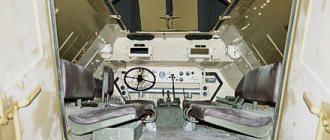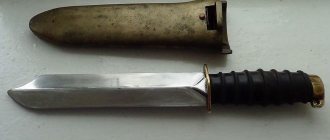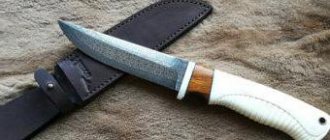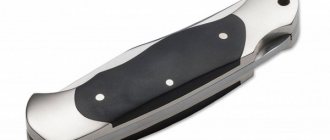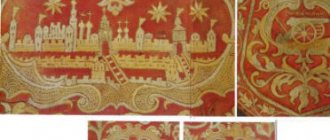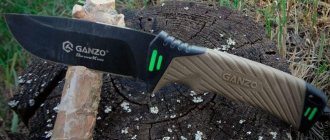Sling knife
Sling knife of the airborne troops of the USSR. Sling knife
of the armed forces of the GDR.
Sling knife
- the first and most famous type of sling cutter. Special knife for cutting slings, belts, ropes, ropes, nets. Initially, the lanyard knife was intended for paratroopers as a tool for their own rescue: with its help, you can get rid of the main canopy of the parachute if it did not open or become entangled, or free yourself after an unsuccessful landing (on a tree or in the water). The sling knife was adopted by various armed forces around the world in the late 30s and early 40s of the 20th century.
Mass production of this knife was associated with the development of airborne troops on the eve of World War II.
Some famous strop cutters
- Kappmesser M 1937
- folding knife of German paratroopers during the Second World War. Opening the blade is possible with one hand, gravitational (the blade falls out under its own weight) or inertial (due to a sharp swing). Additionally, the handle has a pile for unraveling ropes. Despite the utilitarian purpose of this knife, during the war there were legends about its use as a bladed weapon. - A modern German sling knife
is a clumsy knife with a wide blade. Available in several modifications. - The knife-sling knife of the airborne troops of the USSR Armed Forces
is a non-folding knife with a symmetrical double-edged blade. The cutting edge line is concave with serrated sharpening. The tip of the blade is rounded for safety. It was produced with a plastic sheath, as well as with a sheath made of leather or leatherette. The blade is thick, diamond-shaped, and has the serial number of the knife on it. The effectiveness of this sling cutter was questionable, so many paratroopers preferred to carry an ordinary sharp knife with them during a jump. - A modern Russian sling knife
with an automatic blade that jumps forward from the handle. There is no piercing point, the tip of the blade is rectangular. - Victorinox rescue tool
is a folding knife manufactured by Victorinox, a tool for rescue services. In addition to a regular knife, it includes a sling knife.
Luftwaffe: Uniforms, insignia, equipment and weapons of the German Air Force on the website antik1941.
1935-1945 Luftwaffe (German: Luftwaffe - air branch) - the name of the German air force within the Reichswehr, Wehrmacht and Bundeswehr.
In Russian, this name is usually applied to the Wehrmacht Air Force of the Third Reich period (1933-1945). Here is a description of several examples of uniforms. The Fliegerbluse, or flight jacket, was introduced in 1935, i.e. the year the Luftwaffe was founded. It was a shortened tunic without a “skirt” or cuffs, and did not have breast or side pockets or external buttons. The officer version of the jacket had two side, oblique, welt pockets without flaps. Until October 1, 1940, there were no breast eagles on the vests of lower ranks. This emphasized the exclusively working nature of the jacket, created, like the tanker's armored jacket, for combat work. Officers' and generals' vests appear to have had Luftwaffe breast emblems from the very beginning. The Fliegerblues was intended for all Air Force personnel from soldiers to senior commanders. Military officials could also wear it. Like the panzerblouse (or feldblouse), the flight jacket soon became such a popular type of uniform that on October 1, 1940 it received full rights to an eagle, non-commissioned officer braid and an officer's twisted cord along the edge of the collar. Almost simultaneously (November 19), side pockets with flaps appeared on jackets. During the war, they began to make jackets with chest patch pockets, but since all the old designs were not canceled, jackets without pockets were worn until the very end. As a rule, a flierblouse was worn with an open collar. The neck was covered with a gray muffler or non-statutory neckerchiefs (red, blue) with white polka dots, popular in some squadrons. In the formal or weekend versions, a gray-blue shirt with a black tie was worn underneath. Despite the popularity of the fligerblouse, ceremonial officer belts and aiguillettes were still not worn with it.
The Waffenrock (or Anzugrok, meaning "closed jacket") was introduced into the German Air Force on November 11, 1938. It differed from the tukhrok only in that it could be worn buttoned under the neck, for which it had one more button, as well as a hook. It was often worn unbuttoned. Officers' Waffenrocks had high cuffs on the sleeves, and their collars were trimmed with silver cord. For lower ranks, the edge of the collar was trimmed with a colored flagellum according to the waffenfarbe, and for non-commissioned officers it was also trimmed with 9-mm aluminum braid (or silk braid). Everything is the same as in the case of two-rock.
Uniform of the Luftwaffe parachute units
Luftwaffe paratroopers and their uniforms Initially, parachute units were created in Wermath, but later they were transferred to the Luftwaffe. The German army had parachute (Fallschirmtruppen) and airborne (Luftlandentruppen) divisions. The personnel of the parachute division landed with parachutes or on gliders. Units of the air landing division were delivered by transport aircraft, such as Ju-52/Zm, directly to the landing site, using the landing method. In German military sources, parachute troops are officially called “parachute-jaeger” (Fallschirmjager).
German paratroopers wore the uniform adopted by the Luftwaffe. They were given a white dress uniform and a blue-gray or sand-colored (tropical) everyday uniform. A distinctive symbol of the German paratrooper was a yellow neckerchief, which first appeared in North Africa. However, these scarves or scarves were not always the color of yellow gold, but always bright. Over the uniform, a jumpsuit (Fallschirmkittel) was worn - practical clothing made of thick cotton. Swinging down to the bottom, with a hidden button closure and later a zipper, the feldgrau-colored jumpsuit with a low stand-up collar was nicknamed the “bag of bones.” At first there were no pockets on the upper chest and on the trouser legs, which were shortened to mid-thigh. Then horizontal welt pockets with zippers appeared on the hips, and two vertical chest pockets slanted towards the shoulders had leaves that covered the zippers. The sleeves were fastened with cuffs with buttons. Straight-cut feldgrau-colored trousers were worn with the overalls worn over the field uniform. On the side seams at the knees there were pockets with flaps and three buttons, intended for a knife, dressing material and other essentials. Quadruple kapok shock absorbers were sewn into the knee parts of the trousers, and during landing, in order to avoid injuries, they also wore thick kapok or rubber knee pads, stitched with bolsters, with tightening ribbons and buckles. Both the knee pads and the overalls themselves were usually discarded after landing, although the overalls were sometimes left in order to put a harness over it.
On our website we offer for sale original samples of German uniforms, including Luftwaffe units. All these are trophies, museum exhibits and things that are in no way intended for propaganda. This is only a reflection of history and cultural and historical values inherited from the defeated enemy in battles
Safety lanyard cutter
Safety strap cutter (shown by arrow). Element of the handle of a folding knife.
Sling cutter in a Victorinox folding knife.
A safety strop cutter is a tool in the form of a small gripper (hook) with a blade inside. It is almost impossible to get hurt with such a sling cutter. Among skydiving athletes, the safety sling cutter was called “pelican” because of its external resemblance to a half-open beak.
Sometimes a sling cutter is a section of a blade with serrated sharpening on a regular knife.
Second modification of the gravity knife
The main distinguishing feature of the second modification was the likelihood of quickly disassembling the knives into their component parts for cleaning or replacing damaged blades with new ones, without additional tools. The guards and levers of the clamps were no longer nickel-plated, but were oxidized and became dark in color. Now not only paratroopers, but also pilots and tank crews were armed with gravity knives.
When the British took possession of samples of German strop-cutting knives, they decided to produce the same knives themselves to equip their special forces. One of the English enterprises produced five hundred gravity knives.
These knives have become almost exact copies of German strop-cutting knives. As a result, the total number of English gravity units produced during the war years was approximately three thousand two hundred units. Some military experts argued that all the knives left after the war were dealt with unpredictably. They were all gathered in one place and drowned somewhere in the depths of the North Sea.
The first post-war models of sling cutters were released in 1955. This happened a year after the revival of the Airborne Forces within the West German armed forces. The knives were made by a company that made cutlery. They had non-separable designs, and the absence of piles made the knife handles thinner in comparison with knives of previous modifications.
The blades, their mouths and anti-corrosion locking levers were nickel-plated. The black grips on the handles were plastic and grooved with three parallel stripes to make them more secure in the hand. The mouths of the handles were closed with folding plugs to prevent contamination.
Application
Initially, a sling cutter was an item of equipment for a parachutist. With its help, you can free yourself from the unopened canopy of the main parachute in the air or detach yourself after an unsuccessful landing, for example, on the crown of a tree.
Currently, sling cutters are also used in sailing, diving, rock climbing and mountaineering.
Sling cutters are part of the equipment of rescue services. In particular, they are used to cut seat belts to free victims of car accidents.
History of the creation of the sling cutter
Parachutes came into widespread use among flight personnel in the early 20s of the last century. Over the course of 10 years, many improved and new modifications have been developed that are not particularly reliable. They began to be used for intentional jumps in the 30s.
For example, the parachute design in Nazi Germany had the impossibility of quickly assembling the canopy by adjusting the lines along the length. In this regard, fighters in gusty winds often found themselves in an awkward position when they were dragged along the ground and overturned. The landing knife allowed freedom, had compact dimensions and low weight. The first modification was the Kappmmesser sling cutter and the FKM cutter. They began to be used en masse in 1937. These versions were distinguished by their durability and ease of operation, which led to their popularity throughout the world.
